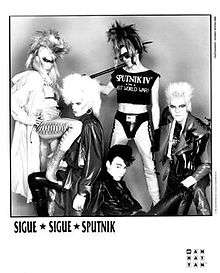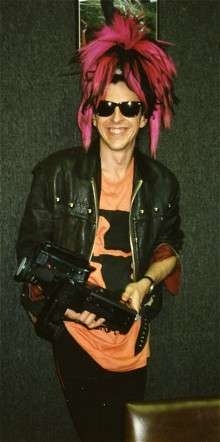Sigue Sigue Sputnik
| Sigue Sigue Sputnik | |
|---|---|
 Sigue Sigue Sputnik, 1986. | |
| Background information | |
| Origin | London, England |
| Genres | New wave, post-punk, glam punk, electronica |
| Years active | 1982–1989, 1995, 1998, 2001–present |
| Labels | Parlophone, EMI Records, Sputnikworld Ltd |
| Past members |
Tony James Neal X Martin Degville Chris Kavanagh Ray Mayhew Yana YaYa Bob "Derwood" Andrews John Green Christopher Novak Claudia Cujo |
Sigue Sigue Sputnik were a British new wave band formed in 1982 by former Generation X bassist Tony James. The band had three UK Top 40 hit singles, including the song "Love Missile F1-11" and "21st Century Boy".
History
Early years

The band was formed by Tony James, who had just left the band Gen X,[1][2] and Neal X (Whitmore), who recruited "post-punk drag queen" Martin Degville. Degville was a clothes designer and supplied the band's wardrobe, and YaYa, the store where he worked, became the band's base.[1] Their first gig was in Paris, supporting Johnny Thunders, with James' former Gen X colleague and then drummer for Thunders, Mark Laff, on drums.[1]
Mick Jones, formerly of The Clash, worked with the band as live sound engineer, helped manipulate their sound, and appeared with them when they opened for New Model Army.[1] Fachna O'Kelly, manager of The Boomtown Rats who had provided much of the band's equipment, provided the band with the name Sigue Sigue Sputnik, as a supposed reference to a Russian street gang and supposedly meaning "burn, burn satellite".[1][2] The band's sound was, according to James, arrived at by accident, when he inadvertently mixed elements of film soundtracks with their demo track "Love Missile F1-11" while putting together a video compilation from his favourite films.[1]
Commercial success (1984–1989)
Interest in the band increased sharply in 1984 after James was interviewed by the NME, with several record companies sending representatives to their next performance at the Electric Cinema in London, and they were invited to perform on The Tube.[1] The band were signed by EMI, with the band themselves claiming in the press that they had signed for one million pounds, though in actual fact revealed to be £350,000.[3] The band's first single, the Giorgio Moroder-produced "Love Missile F1-11", was released in February 1986, and reached number 3 in the UK Singles Chart, number 2 in South Africa and was a major hit in several countries in Europe and Asia.[1][4] Its popularity was boosted by its inclusion in the John Hughes film Ferris Bueller's Day Off. The samples used in the single had not received copyright clearance, and were replaced in the US version.[1] The follow-up, "21st Century Boy" reached number 20 in the UK and, despite largely negative reviews, the album that followed, Flaunt It, again with Moroder at the controls, went top ten in the UK, and also reached number 96 in the US.[1] The album included paid commercials between tracks,[5] James stated prior to its release that they would sell 20-30 second advertising slots for between $2,500 and $7,000.[6] He explained this by saying "commercialism is rampant in society. Maybe we're a little more honest than some groups I could mention," and "our records sounded like adverts anyway".[7][8] Advertisements that did sell (including spots for i-D Magazine and Studio Line from L'Oréal) were complemented by ironic spoof ads including one for the Sputnik corporation itself claiming that "Pleasure is our Business".[4] A subsequent tour was characterised by poor ticket sales and crowd violence.[9]
It was two years before the band followed this up, and subsequent releases fared less well. The Stock Aitken Waterman produced "Success" peaked at number 31 in late 1988 and the singles that followed peaked outside the top 40.[1] Second album Dress for Excess peaked at number 53 in the UK but sold well in Brazil.[1] The band split up in July 1989, with James joining The Sisters of Mercy later that year.[1] Chris Kavanagh went on to Big Audio Dynamite II joining Mick Jones.[4] Mayhew formed Mayhem Deranged. Degville claimed to have spent the next few years travelling and making a couple of "specialist" porn films.[8]
A collection of early demo recordings from 1984 and 1985, along with three tracks from 1990, First Generation, was released in 1991.[10]
Reunions

In 1995, James, X, and Kavanagh formed a new version of the band with Christopher Novak (vocals), John Green (keyboards), and former Gen-X guitarist Bob "Derwood" Andrews.[1] Their song "Cyberspace Party" was a major hit in Japan, and an album, Sputnik: The Next Generation, was released there, selling 50,000 copies.[1] The band split up again but was reformed by James again in 1998, this time with Degville back on vocals and with Claudia Cujo on drums, as Sputnik 2.0.[1] The band was reformed again in 2001 by Degville, James, and X; which resulted in the release of Piratespace.[8][11] In 2004, Degville left the band to pursue a solo career, and has performed as Sputnik2, Sputnik2 The Future, and Sigue Sigue Sputnik Electronic (SSSE). Neal X has been playing with Marc Almond.[4] James later formed the group Carbon/Silicon with Mick Jones.
Image
James claimed that he had chosen his bandmates for their looks, and the band's slogan was "Fleece the World".[7] James billed the band as "Hi-tech sex, designer violence, and the fifth generation of rock 'n' roll".[2]
The themes and imagery in the band's songs were often influenced by futuristic, dystopian or post-apocalyptic films such as A Clockwork Orange, The Terminator, Blade Runner and the Mad Max trilogy.[2][4] Visually, their image included fishnet masks and brightly coloured wigs.
The band's music, image and inspiration also mashed together a range of other pop culture influences, including former Tronics member Zarjaz[12] and electronica influences of Suicide and the New York Dolls.[4]
Members
- Tony James - space guitar, electric guitar, synth guitar, bass guitar, keyboard, backing vocals (1982-1989, 1995, 1998, 2001-present)
- Neal X - electric guitar, backing vocals (1982-1989, 1995, 2001-present)
- Martin Degville - lead vocals (1982-1989, 1998, 2001-present)
- Chris Kavanagh - drums, electronic drums (1982-1989, 1995)
- Ray Mayhew - drums, electronic drums (1982-1989)
- Yana YaYa (Jane Farrimond) - keyboards, space echo, special effects, effects (1982-1989)
- Bob "Derwood" Andrews - electric guitar (1995)
- John Green - keyboards (1995)
- Christopher Novak - lead vocals (1995)
- Claudia Cujo - drums (1998)
Discography
Albums
- 1986 Flaunt It - UK No. 10
- 1988 Dress for Excess - UK No. 53
- 1996 Sputnik the next generation
- 2001 Piratespace
- 2002 Blak Elvis vs. The Kings of Electronic Rock and Roll
- 2003 Ultra Real
- Compilations
- 1990 The First Generation
- 1997 The First Generation – Second Edition
- 1998 The Ultimate 12" Collection
- 1999 Flaunt It + Dress for Excess - French single CD edition of both albums (minus "Success" and "Dancerama").
- 2000 Sci-Fi Sex Stars
- 2001 21st Century Boys: The Best of Sigue Sigue Sputnik
- 2003 The First Generation - Vid Edition[13]
- 2008 1984 Flaunt It: Demos and More
Singles
- 1986 "Love Missile F1-11" - UK No. 3, SA No. 2[14]
- 1986 "21st Century Boy" - UK No. 20
- 1986 "Massive Retaliation"
- 1986 "Sex Bomb Boogie"
- 1986 "Sci-Fi Sex Stars"
- 1988 "Success" - UK No. 31
- 1989 "Albinoni vs. Star Wars" - UK No. 75
- 1989 "Dancerama" - UK No. 50
- 1989 "Rio Rocks"
- 2001 "Love Missile F1-11" (Westbam remix)
- 2002 "Everybody Loves You"
- 2004 "Grooving With Mr. Pervert"[13]
Other album appearances
- 1990 David Bowie Songbook
- 1990 A Tribute to Prince:Party O' The Times
- 2000 Virgin Voices: A Tribute To Madonna - Volume Two
- 2000 Don't Blow Your Cover: A Tribute to KMFDM
- 2000 Covered In Nails: A Tribute To Nine Inch Nails
- 2001 A Gothic-Industrial Tribute to The Smashing Pumpkins
- 2011 ALL TIME SUPER GUEST HOTEI with FELLOWS
Videography
- 2003 Live in Tokyo - DVD
References
- 1 2 3 4 5 6 7 8 9 10 11 12 13 14 15 16 Thompson, Dave (2000). Alternative Rock. Miller Freeman. pp. 615–16. ISBN 9780879306076.
- 1 2 3 4 Handelman, David (1986) "Sigue Sigue Sputnik: 'Fantasy band?'", Gettysburg Times, 8 August 1986, p. 26, retrieved 2010-09-25
- ↑ Hibbert, Tim (12 March 1986). "Sigue Sigue Sputnik (feature)". Smash Hits. EMAP Metro. 8 (4): 27.
- 1 2 3 4 5 6 Schabe, Patrick (2003) "TONY JAMES AND THE ARGONAUTSSS", PopMatters, 29 May 2003, retrieved 2010-09-25
- ↑ Newsweek, Volume 108, p. 43
- ↑ Goddard, Peter (1986) "Sigue Sigue Sputnik is out to sell the sounds of silence", Toronto Star, 27 July 1986
- 1 2 Sanderson Healy, Lauren (1986) "With Cynical Hype, Five British Rockers Ride Sigue Sigue Sputnik to Semistardom", People, Vol. 26, No. 8, 25 August 1986, retrieved 2010-09-25
- 1 2 3 Leigh, Danny (2001-02-09). "'I just kept cool, you know. Travelled. Did a couple of porn movies'". The Guardian. Retrieved 2011-03-12.
- ↑ Sigue Sigue Sputnik - Where Are They Now?: Yahoo Music, 20 May 2010
- ↑ Popson, Tom (1991) "Early Sigue Sigue Sputnik unearthed", Chicago Tribune, 5 April 1991
- ↑ "Sputnik set to go into orbit again", Evening Times, 19 January 2001, p. 32
- ↑ "The 80s Fight Back", Record Collector, July 1988, Issue 227, p. 6
- 1 2 Roberts, David (2006). British Hit Singles & Albums (19th ed.). London: Guinness World Records Limited. p. 498. ISBN 1-904994-10-5.
- ↑ Brian Currin. "South African Rock Lists Website - SA Charts 1969 - 1989 Acts (S)". Rock.co.za. Retrieved 2014-05-22.
External links
| Wikimedia Commons has media related to Sigue Sigue Sputnik. |